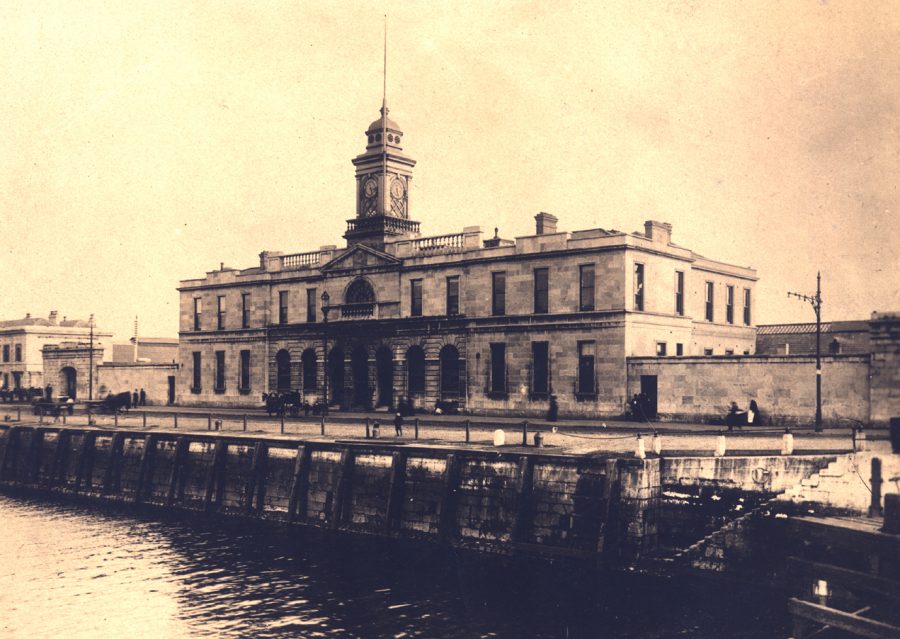Kieran’s Our City, Our Town Article,
Cork Independent, 8 October 2020
Remembering 1920: The Attack on City Hall

1069a. Old Cork City Hall, c.1920 (source: Cork City Through Time by Kieran McCarthy & Dan Breen).
Reprisals by the Black and Tans for the Barrack Street Ambush on Friday 8 October and for the connected death of Private John Gordon Squibbs were quick. The stakes were heightened again when that Friday night City Hall (old) was targeted by the Tans for an arson attack. Even though it was not fully successive, much damage was caused. The attack commenced about 3.45am, when a volley of shots was fired evidently from rifles at the building. The witness to the attack was the building’s night watchman who described to the Cork Examiner how the events unfolded.
The firing ceased after a few minutes, and all was again quiet for some ten minutes or so, when there was a renewed outburst of rifle firing. While the second volleys were being fired the night watchman heard two loud bomb explosions. He went into the vestibule of the City Hall and saw that the western portion of the building was in flames. He had already telephoned the city’s Fire Brigade when he had heard shots, and now when he saw the conflagration in the Public Health Offices he again communicated to the brigade.
The fire brigade, under Captain Alfred Hutson, were not slow to arrive. Lines of hose were speedily laid, and water was soon poured into the Public Health and Waterworks offices. The flames at first spread with alarming rapidity, and at one time it looked as if that portion of the Hall would be completely burnt out. The strenuous efforts of the members of the fire brigade, however, soon brought it under control. After several hours, the flames were overcome, and the fires subdued. Two men were left in charge for the remainder of the morning.
The destruction of the offices of Public Health and the Waterworks, and the adjoining offices was very considerable. Document, records, and other literature relating to municipal affairs were all were destroyed. The windows in this portion of the building, looking out on the river, were all smashed, and it was obvious that the bombs, which exploded in the building were hurled through these windows. In the interior of the building there is ample evidence of the destruction wrought by the bomb explosions. In the Public Health Department, picture frames and other accessories were smashed to pieces by the force of the explosion, as was also the fender of the fireplace. A bomb, which exploded in the eastern portion of the building, also caused considerable damage.
At this side of City Hall were situated the lamplighter and watchman’s shed and further back was a yard in which wheelbarrows, spades, and similar implements were kept. The bomb appeared to have exploded in the centre of the yard, and the ground was all torn up, with one of the wheelbarrows badly damaged. The rifle firing seemed to have occurred at the other side of the building for the walls and ceilings around the Public Health and Waterworks Office’s bore several bullet marks.
Immediately overhead, the City Engineer’s department narrowly escaped destruction both from the conflagration and the bombs which were hurled up at the windows. One bomb, indeed, entered, and exploded in a corner near a safe, blowing portion of a floor away.
Later on that weekend, on Sunday 10 October 1920 large parties of RIC, working in conjunction with the Black and Tans, carried out a very unexpected raid in Cork City Centre. The streets were, as usual on Sunday afternoon, thronged at the time, and the sudden swoop created much alarm and panic. About 2.40pm the police and the Black and Tans took possession of MacCurtain Street, Coburg Street, Bridge Street, St Patrick’s Bridge, St Patrick’s Street, the Grand Parade, and other thoroughfares in the centre of the city. The lorries in which the military arrived were escorted by armoured cars. Cordons were drawn across the streets at several points and the large numbers of people on the streets at the time found themselves surrounded military or police pickets.
As the civilians were ordered to halt, they were obliged to submit to be searched. Even those outside the cordons, but in the immediate vicinity, were not exempt from the searches. For the most partthe people quietly allowed themselves to be searched, after which they were permitted to go outside the cordons, and wherever they wished.In this manner hundreds of civilians were searched.
In some cases, the military commands to halt were not obeyed, and one man, who it is stated, did not halt when called upon to do so, was shot. His name is given was Michael Griffin, a labourer, aged about 60 years residing in Cattle Market Street, Cork. It appears that he was passing through Merchant street at the time, and was called upon to “halt”, but either did not hear or refused to obey the challenge. The Black and Tans opened fire and he was struck by a bullet. The wounded man collapsed and was unable to move The Corporation ambulance was sent for and was quickly on the scene. He was conveyed to the South Infirmary but in the hours that followed he died. The military parties withdrew from the streets about 3.45pm, having made one arrest. Such policing manoeuvres only increased as October and November 1920 progressed.
More next week…
This week’s column marks the 21st year mark of Our City, Our Town (started in early October 1999). Thanks to everyone for their support along the journey.
My new book Witness to Murder, The Inquest of Tomás MacCurtain is now available to purchase online (co-authored with John O’Mahony 2020, Irish Examiner/www.examiner.ie).
Captions:
1069a. Old Cork City Hall, c.1920 (source: Cork City Through Time by Kieran McCarthy & Dan Breen).